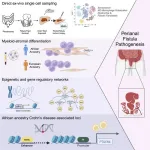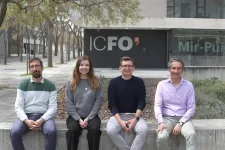Recent developments at MD Anderson offer insights into a novel targeted therapy for rare cancers, the role of enhancer RNAs in cell differentiation, novel biomarkers for the prognosis and treatment of pancreatic cancer, imaging signatures to stratify patients with non-small cell lung cancer (NSCLC), a novel platform to study the underlying clinical and molecular mechanisms of prostate cancer, the role of telomere dysfunction and aging on colorectal cancer initiation, and a novel therapeutic target for patients with newly diagnosed acute myeloid leukemia (AML).
Cabozantinib demonstrates encouraging antitumor activity in rare cancers
Rare cancers are difficult to study in a clinical trial setting due to the relatively small number of patients. Two studies recently published in The Lancet Oncology examined the use of cabozantinib, an antiangiogenic multi-tyrosine kinase inhibitor, on two rare cancers: adrenocortical carcinoma, an endocrine cancer, and metastatic phaeochromocytomas and paragangliomas (MPPGs), both neuroendocrine tumors. Notably, these two cancers have just one FDA approved treatment each. The studies highlight the therapeutic potential of cabozantinib in combination with other therapies to improve outcomes for patients with rare cancers.
In a first prospective Phase II study, researchers led by Matthew Campbell, M.D., and Mouhammed Amir Habra, M.D., evaluated cabozantinib in 18 patients with adrenocortical carcinoma. Thirteen patients (72%) had progression free survival longer than four months, with a manageable safety profile consistent with cabozantinib use in other cancer types. The study supports further investigation of cabozantinib in combination with immune checkpoint inhibitors. Learn more here.
The Phase II Natalie Trial, led by Camilo Jimenez, M.D., examined the use of cabozantinib in 17 patients with MPPGs. Patients had an overall response rate of 25% with a median follow-up of 25 months. Cabozantinib was associated with tumor size reduction and prolonged disease stabilization. In all patients, the response was independent of their genotype, with 136 genes tested. However, MPPGs can develop resistance to cabozantinib, and 94% of patients discontinued participation due to disease progression. The study suggests cabozantinib merits further investigation in combination with targeted therapy or immunotherapy. Learn more here.
Enhancer RNA plays crucial role in cell differentiation
One of the most frequently mutated epigenetic factors in cancer is a large protein complex called SWI/SNF, which regulates gene transcription and is crucial for proper cell differentiation. An important question has been how SWI/SNF is recruited to cell-type-specific regions of DNA, called enhancers. Researchers led by Blaine Bartholomew, Ph.D., found a special class of non-coding enhancer RNA (eRNA) that recruits SWI/SNF to cell-type specific enhancers involved in the switch from undifferentiated to differentiated cells. By initially recruiting SWI/SNF, the eRNA promotes the assembly of transcription factors and co-activators onto these enhancers. The study shows that super-enhancers, which are known to be important in determining cell identity and are often targeted in cancer, also are activated by eRNA and SWI/SNF. Learn more in Molecular Cell.
Study identifies pathway involved in suppressing KRAS G12D-mutant pancreatic cancer
Pancreatic cancer is notoriously aggressive and difficult to treat, underscoring the need for more effective therapeutic targets. Research led by Jie Fu, Ph.D., Jianhua Ling, Ph.D., and Paul Chiao, Ph.D., previously showed that apoptosis, or cell death, resistance in KRAS G12D-mutant pancreatic cancer was accelerated by deleting the Plk3 tumor suppressor, but the regulatory mechanism of Plk3 activation remains unknown. To provide further insights, the researchers examined the role of Plk3 in KRAS G12D-mutant pancreatic cancer models. They found that the nardilysin (NRDC) enzyme cuts a Plk3 precursor, resulting in Plk3 activation that promotes apoptosis and suppresses cancer progression and metastasis. The study provides insights into this post-translational modification, highlighting NRDC and Plk3 as potential biomarkers for prognosis and treatment response. The findings suggest that targeting this pathway is a potential therapeutic strategy for patients with KRAS G12D-mutant pancreatic cancer. Learn more in Nature Communications.
Novel framework incorporates PET/CT imaging to better predict recurrence in patients with lung cancer
The independent contribution of routine radiology scans in predicting recurrence in patients with non-small cell lung cancer (NSCLC) is relatively unexplored. In a new study of 394 NSCLC patients, led by Jia Wu, Ph.D., Tina Cascone M.D., Ph.D., and Jianjun Zhang, M.D., Ph.D., researchers developed a proof-of-concept imaging framework to stratify patients into three clinically meaningful subtypes with distinct prognoses. These subtypes add to the prognostic information obtained from clinicopathological risk factors and ctDNA alone, and they could potentially serve as an earlier indicator of recurrence. This framework analyzes and identifies distinct intratumoral sub-regions, or habitats, which the researchers validated as prognostic biomarker signatures for patients with NSCLC. If further validated, this imaging signature could be used to refine individualized therapies in patients with lung cancer. Learn more in Nature Communications.
Comprehensive prostate cancer platform serves as resource for therapeutic strategies
Metastatic prostate cancer that is unresponsive to current treatments is incurable, partly due to a lack of models that accurately represent and recreate the underlying conditions behind this resistance. To address this gap, Nicolas Anselmino, Ph.D., Estefania Labanca, Ph.D., Nora Navone, M.D., Ph.D.*, and colleagues, used 44 patient-derived xenograft (PDX) models from 38 patients with various stages of prostate cancer. They integrated whole-genome, targeted and RNA sequencing on representative samples of the same tumor, along with patient databases, to comprehensively characterize the differences among the tumors. This unique platform serves as a valuable resource to further study the underlying clinical and molecular mechanisms of prostate cancer progression and to help identify potential therapeutic targets that may improve patient outcomes. Learn more in Clinical Cancer Research.
*Senior author Nora Navone, M.D., Ph.D., passed away in December 2023, before the publication of this study. She is remembered as an accomplished translational scientist and generous mentor who championed her teammates’ success.
Early stages of telomere dysfunction contribute to cancer initiation
Telomeres are protective caps at the ends of chromosomes that shorten with age, becoming dysfunctional and contributing to epithelial cancers, such as colorectal cancer (CRC). To examine how telomere dysfunction influences cancer initiation, researchers led by Ronald DePinho, M.D., studied intestinal stem cell dynamics and tumor origination in CRC models with loss-of-function mutations in the APC gene. These mutations deregulate the Wnt signaling pathway, which is important for stem cell growth and maintenance; dysregulation can lead to abnormal cell proliferation and invasive carcinoma. The researchers found that telomere dysfunction suppresses the EZH2 protein, which increases Wnt pathway activity, favoring the growth of cancer cells over normal stem cells. Additionally, using a drug to regulate Wnt signaling can reverse these effects and prevent tumor formation. The findings suggest that targeting Wnt signaling in normal stem cells may be a potential therapeutic strategy for patients with APC-mutant genetic predispositions and shortened telomeres. Learn more in Developmental Cell.
CD7 expression is linked with poor overall survival in patients with newly diagnosed AML
Not expressed by normal myeloid precursors, CD7 is found in 25-30% of newly diagnosed acute myeloid leukemia (AML) cases. In a retrospective study led by Wei-Ying Jen, M.D., Naval Daver, M.D., and Courtney DiNardo, M.D., researchers observed that CD7 expression was associated with poor overall survival (OS) in newly diagnosed patients with AML, further highlighting the potential benefit of CD7-directed approaches. Researchers examined the genomic profiles and outcomes of 901 patients with AML, of which 29.2% were CD7-positive. These patients had a median OS of 11.9 months, compared to 19 months in those with no CD7 expression. The study suggests that CD7 may be a promising target for therapeutic strategies in newly diagnosed patients with AML. Learn more in British Journal of Haematology.
In case you missed it
Read below to catch up on recent MD Anderson press releases.
Study opens new avenue for immunotherapy drug development Four MD Anderson researchers elected AAAS Fellows MD Anderson and CureVac enter strategic collaboration to develop novel cancer vaccines Read this press release in the MD Anderson Newsroom.
- 30 -
END




